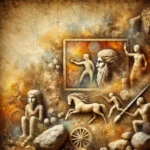In the world of African folklore and literature, few mythical characters are as captivating as Dadiyanki. Rooted in ancient traditions, Dadiyanki is not only a symbol of cultural richness but also a vital element of storytelling, shaping narratives that transcend generations. In this blog post, we will delve into the essence of Dadiyanki, uncovering its literary and entertainment significance, while also exploring its influence on modern culture.
Table of Contents
ToggleThe Origins and Role of Dadiyanki in Folklore:
Dadiyanki emerges from the oral traditions of various African tribes, acting as both a guardian and trickster figure. Often portrayed as a being of immense wisdom and cunning, Dadiyanki navigates complex human emotions, helping people understand their lives through stories and parables. As in many traditional African narratives, Dadiyanki doesn’t follow conventional moral norms but rather represents the grey areas of human existence.
Key Points:
-
Cultural Relevance:
Dadiyanki plays an integral role in shaping moral, ethical, and social values through the telling of stories.
-
Literary Influence:
As an entity deeply embedded in the oral literature of Africa, Dadiyanki’s stories are filled with wit, humor, and life lessons that transcend cultures and time periods.
Dadiyanki’s Role in Entertainment and Literature:
In literature, Dadiyanki offers an intersection between tradition and modernity. African writers and scholars have used Dadiyanki as a literary device, incorporating the figure in both contemporary and classical works. Whether through novels, plays, or poems, Dadiyanki symbolizes resilience, adaptability, and the duality of human nature.
One example of such integration is in modern African literature, where writers explore the character’s complexity. Dadiyanki is often depicted as a guide or a symbol of rebellion, helping characters navigate the moral dilemmas they face.
Literary Works Featuring Dadiyanki:
-
Folklore Anthologies:
Dadiyanki’s tales are compiled into collections of African folklore, helping readers understand the character’s role in African storytelling.
-
Modern Interpretations:
African authors have reimagined Dadiyanki in modern contexts, showing the character’s relevance in today’s social and cultural issues.
For an example of how ancient characters like Dadiyanki influence contemporary media, take a look at View Episode 141, where traditional themes intersect with modern storytelling.
How Dadiyanki Shaped African Theater and Film:
Dadiyanki’s influence extends beyond literature to theater and film, where the character continues to inspire performances that resonate with both African and global audiences. African theater, particularly the plays that focus on moral questioning and societal roles, often include characters based on Dadiyanki. These performances help bring African literature to life, bridging the gap between the written word and visual storytelling.
In cinema, Dadiyanki’s stories have been adapted to reflect modern life while retaining the mystical and moral undertones that define African folklore. Whether it’s through indie films or mainstream African cinema, Dadiyanki’s adaptability ensures the character remains relevant in today’s entertainment world.
The Continued Relevance of Dadiyanki in Popular Culture:
Dadiyanki is a figure that resonates with all ages, making it a timeless character in African literature. Beyond books and plays, Dadiyanki appears in various cultural forms like radio dramas, podcasts, and animated films. The figure’s trickster nature often symbolizes the challenges of life, the ambiguity of moral decisions, and the complexity of human nature.
Dadiyanki’s adaptability has made it a subject of interest in academic discussions, with researchers exploring the deeper meanings behind its stories and character. From the entertainment perspective, Dadiyanki serves as a bridge between generations, as children and adults alike find value in the stories surrounding this character.
For a contemporary take on Dadiyanki’s influence in media, you can also explore our interlinked article View Episode 141.
FAQs:
1. What is the significance of Dadiyanki in African literature?
Dadiyanki plays a crucial role in African literature as a cultural symbol and a literary device. It represents wisdom, moral ambiguity, and the complexities of human life, making it a common figure in folklore, plays, and modern literature.
2. How is Dadiyanki portrayed in modern African media?
Dadiyanki continues to inspire modern African media, from literature to films. In contemporary works, Dadiyanki often serves as a trickster figure, helping characters navigate personal and societal dilemmas. The character’s role in theater and film highlights its enduring relevance.
3. Are there modern adaptations of Dadiyanki’s stories?
Yes, Dadiyanki’s stories have been adapted into modern literature, film, and even podcasts. African authors have reimagined Dadiyanki in ways that reflect today’s societal issues, making the character relatable to contemporary audiences.
4. Why is Dadiyanki important in African folklore?
Dadiyanki holds importance because it conveys life lessons, moral values, and cultural wisdom through storytelling. The character’s ability to navigate between good and evil reflects the complexity of human emotions and societal roles, making it a vital element of African oral traditions.
5. How does Dadiyanki influence modern storytelling?
Dadiyanki’s influence is evident in modern storytelling through its representation of moral dilemmas and the human condition. Writers often use Dadiyanki to symbolize resilience, adaptability, and the ambiguous nature of good and evil.
Conclusion:
Dadiyanki is a vital figure in African folklore and literature, embodying the intricate balance between tradition and modernity. Its tales provide not only entertainment but also a profound exploration of moral and societal issues. Whether in literature, theater, or film, Dadiyanki continues to captivate audiences, proving that the character’s legacy is as enduring as the stories themselves.



